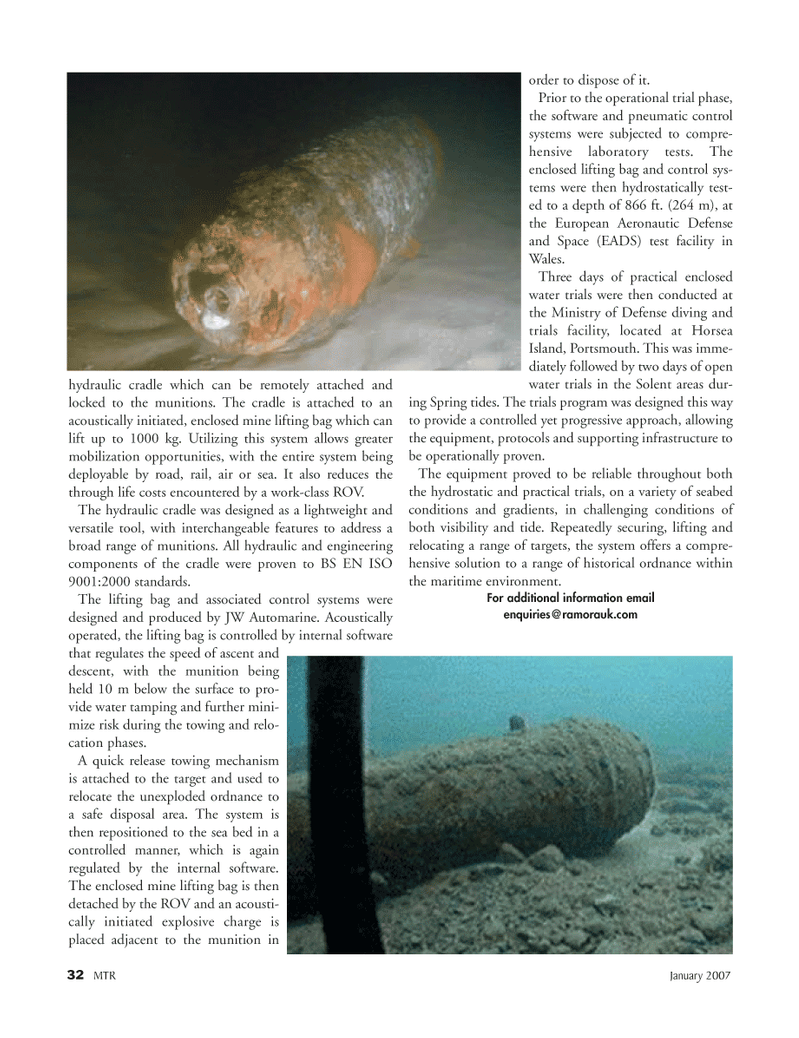
Page 32: of Marine Technology Magazine (January 2007)
Seafloor Engineering
Read this page in Pdf, Flash or Html5 edition of January 2007 Marine Technology Magazine
hydraulic cradle which can be remotely attached and locked to the munitions. The cradle is attached to an acoustically initiated, enclosed mine lifting bag which can lift up to 1000 kg. Utilizing this system allows greater mobilization opportunities, with the entire system being deployable by road, rail, air or sea. It also reduces the through life costs encountered by a work-class ROV.
The hydraulic cradle was designed as a lightweight and versatile tool, with interchangeable features to address a broad range of munitions. All hydraulic and engineering components of the cradle were proven to BS EN ISO 9001:2000 standards.
The lifting bag and associated control systems were designed and produced by JW Automarine. Acoustically operated, the lifting bag is controlled by internal software that regulates the speed of ascent and descent, with the munition being held 10 m below the surface to pro- vide water tamping and further mini- mize risk during the towing and relo- cation phases.
A quick release towing mechanism is attached to the target and used to relocate the unexploded ordnance to a safe disposal area. The system is then repositioned to the sea bed in a controlled manner, which is again regulated by the internal software.
The enclosed mine lifting bag is then detached by the ROV and an acousti- cally initiated explosive charge is placed adjacent to the munition in order to dispose of it.
Prior to the operational trial phase, the software and pneumatic control systems were subjected to compre- hensive laboratory tests. The enclosed lifting bag and control sys- tems were then hydrostatically test- ed to a depth of 866 ft. (264 m), at the European Aeronautic Defense and Space (EADS) test facility in
Wales.
Three days of practical enclosed water trials were then conducted at the Ministry of Defense diving and trials facility, located at Horsea
Island, Portsmouth. This was imme- diately followed by two days of open water trials in the Solent areas dur- ing Spring tides. The trials program was designed this way to provide a controlled yet progressive approach, allowing the equipment, protocols and supporting infrastructure to be operationally proven.
The equipment proved to be reliable throughout both the hydrostatic and practical trials, on a variety of seabed conditions and gradients, in challenging conditions of both visibility and tide. Repeatedly securing, lifting and relocating a range of targets, the system offers a compre- hensive solution to a range of historical ordnance within the maritime environment.
For additional information email [email protected] 32 MTR January 2007
MTR#1 (17-32).qxd 1/11/2007 4:11 PM Page 32

 31
31

 33
33
